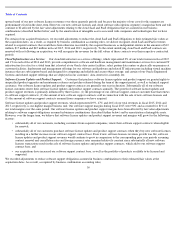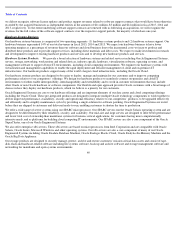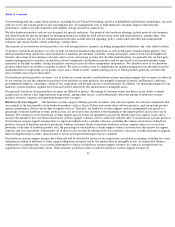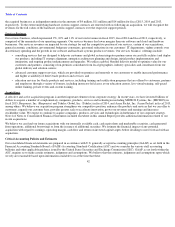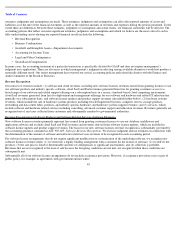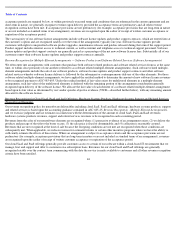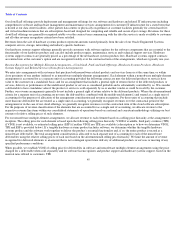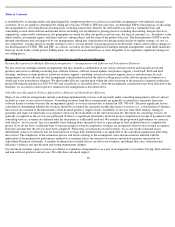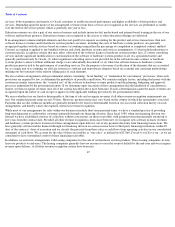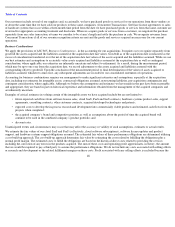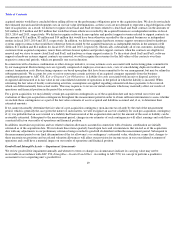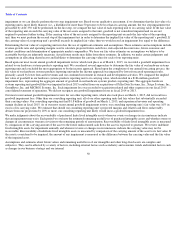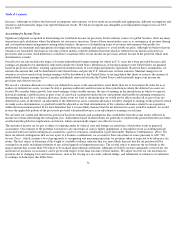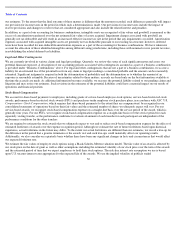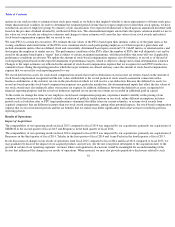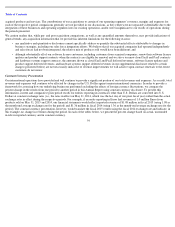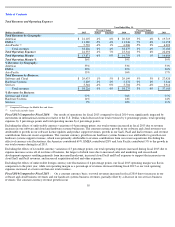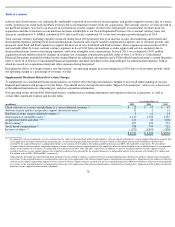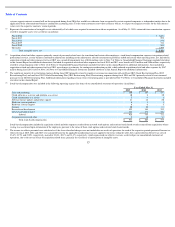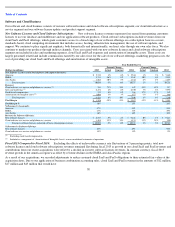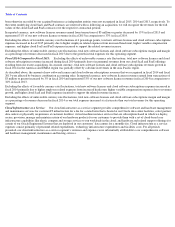Oracle 2014 Annual Report Download - page 53
Download and view the complete annual report
Please find page 53 of the 2014 Oracle annual report below. You can navigate through the pages in the report by either clicking on the pages listed below, or by using the keyword search tool below to find specific information within the annual report.
Table of Contents
acquired entities would have concluded those selling efforts on the performance obligations prior to the acquisition date. We also do not include
the estimated research and development costs in our fair value determinations, as these costs are not deemed to represent a legal obligation at the
time of acquisition. As a result, we did not recognize cloud SaaS and PaaS revenues related to cloud SaaS and PaaS contracts in the amounts of
$12 million, $17 million and $45 million that would have been otherwise recorded by the acquired businesses as independent entities in fiscal
2015, 2014 and 2013, respectively. We did not recognize software license updates and product support revenues related to support contracts in
the amounts of $11 million, $3 million and $14 million that would have been otherwise recorded by the acquired businesses as independent
entities in fiscal 2015, 2014 and 2013, respectively. In addition, we did not recognize hardware systems support revenues related to hardware
systems support contracts that would have otherwise been recorded by the acquired businesses as independent entities in the amounts of $4
million, $11 million and $14 million for fiscal 2015, 2014 and 2013, respectively. Historically, substantially all of our customers, including
customers from acquired companies, renew their software license updates and product support contracts when the contracts are eligible for
renewal and we strive to renew cloud SaaS and PaaS, and hardware systems support contracts. To the extent cloud SaaS and PaaS, software
support or hardware systems support contracts are renewed, we will recognize the revenues for the full values of the contracts over their
respective contractual periods, which are generally one year in duration.
In connection with a business combination or other strategic initiative, we may estimate costs associated with restructuring plans committed to
by our management. Restructuring costs are typically comprised of employee severance costs, costs of consolidating duplicate facilities and
contract termination costs. Restructuring expenses are based upon plans that have been committed to by our management, but may be refined in
subsequent periods. We account for costs to exit or restructure certain activities of an acquired company separately from the business
combination pursuant to ASC 420, Exit or Disposal Cost Obligations. A liability for costs associated with an exit or disposal activity is
recognized and measured at its fair value in our consolidated statement of operations in the period in which the liability is incurred. When
estimating the fair value of facility restructuring activities, assumptions are applied regarding estimated sub-lease payments to be received,
which can differ materially from actual results. This may require us to revise our initial estimates which may materially affect our results of
operations and financial position in the period the revision is made.
For a given acquisition, we may identify certain pre-acquisition contingencies as of the acquisition date and may extend our review and
evaluation of these pre-acquisition contingencies throughout the measurement period in order to obtain sufficient information to assess whether
we include these contingencies as a part of the fair value estimates of assets acquired and liabilities assumed and, if so, to determine their
estimated amounts.
If we cannot reasonably determine the fair value of a pre-acquisition contingency (non-income tax related) by the end of the measurement
period, which is generally the case given the nature of such matters, we will recognize an asset or a liability for such pre-acquisition contingency
if: (i) it is probable that an asset existed or a liability had been incurred at the acquisition date and (ii) the amount of the asset or liability can be
reasonably estimated. Subsequent to the measurement period, changes in our estimates of such contingencies will affect earnings and could have
a material effect on our results of operations and financial position.
In addition, uncertain tax positions and tax related valuation allowances assumed in connection with a business combination are initially
estimated as of the acquisition date. We reevaluate these items quarterly based upon facts and circumstances that existed as of the acquisition
date with any adjustments to our preliminary estimates being recorded to goodwill if identified within the measurement period. Subsequent to
the measurement period or our final determination of the tax allowance’s or contingency’s estimated value, whichever comes first, changes to
these uncertain tax positions and tax related valuation allowances will affect our provision for income taxes in our consolidated statement of
operations and could have a material impact on our results of operations and financial position.
Goodwill and Intangible Assets — Impairment Assessments
We review goodwill for impairment annually and whenever events or changes in circumstances indicate its carrying value may not be
recoverable in accordance with ASC 350, Intangibles—Goodwill and Other . According to ASC 350, we can opt to perform a qualitative
assessment to test a reporting unit’s goodwill for
49


